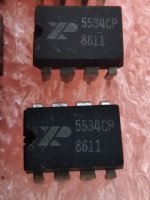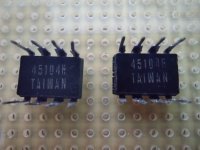There really is a noise difference between the modern generics and original signetics. The lower noise AN version was just a sorted batch with better specs. There is a wide performance spread in the garden variety 5532 / 34 and its pretty noticeable in higher gain circuits. I wws told by a former Philips engineer the input clamping diodes had something to do with that..
I have a lot of signetics , even smd signetics ne5534, also philips , AN and sorts and early Texas Instruments made in Portugal.I remember making a rail bootstrapped unity gain circuit withTI made in portugal , ne5534 following D Se lf advice, employing Bruce Hoffer recommended compensation and ending with lm4562 replacing the whole s...t who was simply glorious.
I think the only place where ne5534 can be good is in circuits with a lot of gain , high input impedance and actually used in bslanced mode to overcome common mode distortions yet i never gave it a try .
Yet I promiss I'll do it some day if i get short of modern op-amps or ultralow noise transistors.
I think the only place where ne5534 can be good is in circuits with a lot of gain , high input impedance and actually used in bslanced mode to overcome common mode distortions yet i never gave it a try .
Yet I promiss I'll do it some day if i get short of modern op-amps or ultralow noise transistors.
Living in the Silicon Valley bubble I was unaware of the Philips origin of the 5534. The Signetics docs claim they invented the 5534. The triumph of marketing over facts.
Walt Jung wrote about the Philips TDA1034 in "The Audio Amateur", long before the Signetics NE5534. That's how quite a few people (including me) found out about it.
It seems like the original datasheet of tda1034 is actually Signetics as advertized in ITT catalogue: https://datasheetspdf.com/mobile/616403/Signetics/TDA1034/1
Later papers of Graeme Cohen from Philips Australia and others mention just ne5534 and ne5532 as op amp cast for their hibryds:
https://leonaudio.com.au/cohen.htm
Philips bought Signetics in 1975, but let them use the name Signetics .It may be that tda1034 was actually Signetics all the way cause there was no reason to sell a Philips original die as Signetics when Signetics was just incorporated into Philips.Signetics invented ne555 which was a much higher succes than any analog op amp ever made as it is still made and sold by the billions...so it was natural for Signetics to be allowed to use their logo even when incorporated into Philips just to make sure that nobody will doubt that ne555 is not an original part.Signetics had a lot of sales of optical couplers and automation ic, it was a major inventor and contributor .ITT bought tons of their designs to be used everywhere.I used to fix a lot of 70's....2000 german industrial machines used in the printing industry and i find a lot of Signetics in them .Philips , later nxp shifted at some point into die making technogies and had less and less influence into design area. Not sure if TDA prefix was a Philips original one, but NE was an original Signetics Prefix .
Later papers of Graeme Cohen from Philips Australia and others mention just ne5534 and ne5532 as op amp cast for their hibryds:
https://leonaudio.com.au/cohen.htm
Philips bought Signetics in 1975, but let them use the name Signetics .It may be that tda1034 was actually Signetics all the way cause there was no reason to sell a Philips original die as Signetics when Signetics was just incorporated into Philips.Signetics invented ne555 which was a much higher succes than any analog op amp ever made as it is still made and sold by the billions...so it was natural for Signetics to be allowed to use their logo even when incorporated into Philips just to make sure that nobody will doubt that ne555 is not an original part.Signetics had a lot of sales of optical couplers and automation ic, it was a major inventor and contributor .ITT bought tons of their designs to be used everywhere.I used to fix a lot of 70's....2000 german industrial machines used in the printing industry and i find a lot of Signetics in them .Philips , later nxp shifted at some point into die making technogies and had less and less influence into design area. Not sure if TDA prefix was a Philips original one, but NE was an original Signetics Prefix .
Last edited:
I have a couple of those. Manufactured in 1986 (?). What is the difference between ACN, CN, and CP suffixes?Those are actually made by Signetics... at least the internal dye is their own.
Attachments
Slew Rate testing for correct shape and spec helped me to screen out fakes. Idle mA testing to spec or not was a quick clue also.I use noise to screen out fake parts.
I have a couple of those. Manufactured in 1986 (?). What is the difference between ACN, CN, and CP suffixes?
Interesting, so still making them in '86. Are those ceramic or plastic package? I'd guess the P stands for the latter, A is for guaranteed offset or noise spec, and C is a 'normal' grade.
If time allows this weekend I'll compare noise performance of units from various makers and time periods, in the mic pre mantioned previously. Though, for a measurement mic, preamp noise is pretty academic.
Definitely plastic. I bought them from a downtown shop back in the day for making a line preamp with output offset trim. After the preamp was no more I pulled them out. They don't come from a modern online auction, no chance they are reprinted. I should have had same period XR 5532s in a diy phono as well. Here's a photo of the XR 5534s "dark side" also.
Attachments
The ACN and CN are tested for noise density and input CMRR but the CP is untested standard version.I have a couple of those. Manufactured in 1986 (?). What is the difference between ACN, CN, and CP suffixes?
I remember working on all the pro gear back in the day, Neve used to spec the A version for all their consoles and i would purchase the op amps through them because they tested them for all sorts of parameters, not just noise.
The biggest differences between all of the varieties of 5532/34s are noise and offset. It was worse in the older Signetics pieces but in general they performed better at higher voltages up to +/- 20V, while the newer generics get much more noisy past +/- 16V. In all of my years of servicing gear, I don't recall replacing a 5534 out of its own fault. They usually die from overvoltage due to a bad Vreg or excess DC fed back into the output. Its a durable chip and still sounds as good as most of the modern bipolar op amps. The key to getting the best sound from this chip is solid supply regulation and decoupling. Never use polarized electrolytics on the output with symmetrical supply rails and pick your capacotors wisely. The NE5532/34 and Nichicon Muse UES caps are a match made in heaven IMO.
My experience dovetails with profiguy's for the most part. I had a nice side-business in the 80's and 90's rebuilding recording/mixing consoles, most of which were stuffed with TL07x's. The most demanding positions were the mic pre's and summing amps. I found that the best-sounding and measuring 553x's had the lowest and most linear CMRR vs freq across the audio band. I put together a test jig to sort them. I went through 100's of Signetics and Raytheon 5534's and (mostly) 5532's. From a tube of 25, typically ~80% would be reasonably flat at around -80-85dB, and 20% would be -100-110dB. Those were the best ones. A-suffix were no different %-wise. (Analog System's MA332 measured just as good; I was told CMRR was one of their selection criteria.) Then I got a tube of standard 5532's where 80% measured -110dB, and on both channels. I called my supplier and bought everything with that date code he had in stock. This happened several more times. Some production runs were way better than others.
After that I never paid the premium for A-suffix 553x's unless I could sample them first.
CMRR on TI's 553x's was not flat and horribly inconsistent. JRC's were consistent but not flat. One of the "super" opamps of that time period, the LT1028, was pretty good but only half of them.
The stellar (sleeper?) CMRR opamp from that period was certain date codes of NatSemi LF353. I won't bore you with the long story of how I was tipped off to this, but I found date codes that measured flat CMRR at -120-130dB, at the noise floor of the measurement. Analog Systems offered a dual FET opamp that was selected from them. LF353 was limited to low-gain uses by noise and 4MHz GBWP, but still excellent diff amps, and cheap.
More recent parts, LM4562 and OPA1642, are both very consistent and flat around -100-105dB. I've never found a bad one. Manufacturing consistency has defiinitely improved.
After that I never paid the premium for A-suffix 553x's unless I could sample them first.
CMRR on TI's 553x's was not flat and horribly inconsistent. JRC's were consistent but not flat. One of the "super" opamps of that time period, the LT1028, was pretty good but only half of them.
The stellar (sleeper?) CMRR opamp from that period was certain date codes of NatSemi LF353. I won't bore you with the long story of how I was tipped off to this, but I found date codes that measured flat CMRR at -120-130dB, at the noise floor of the measurement. Analog Systems offered a dual FET opamp that was selected from them. LF353 was limited to low-gain uses by noise and 4MHz GBWP, but still excellent diff amps, and cheap.
More recent parts, LM4562 and OPA1642, are both very consistent and flat around -100-105dB. I've never found a bad one. Manufacturing consistency has defiinitely improved.
Last edited:
Just for jollies, I measured noise of several 5534's in the mic pre mentioned earlier. A basic AC-coupled diff amp circuit with 20k input Z and 21dB of gain. Measured with an EG&G 7310 voltmeter set for 20kHz lowpass bandwidth (its residual noise is 2.8uV).
I didn't have any TI 5534's, I usually just toss them. The Exar was the worst for noise, and its readings were less stable. The JRC was the winner noise-wise, but only by a scunt. Included for comparison is a Burr-Brown OPA627. With 20k input Z its lower current noise gives it a slight edge.
This agrees with what I found back in the 80's; selecting for noise is a pretty blunt criteria, with no good correlation with audible quality.
Make/model date code noise (uV RMS)
------------ ------------ -----------------
Sig 5524N 8109 29.3
Sig 5534N 8009 29.5
Sig 5534AN 8333 29.9
Sig 5534N 8705 29.7
Exar 5534ACN 8127 32.7
JRC 5534D 5004 29.2
BB OPA627AP 9307 28.8
I didn't have any TI 5534's, I usually just toss them. The Exar was the worst for noise, and its readings were less stable. The JRC was the winner noise-wise, but only by a scunt. Included for comparison is a Burr-Brown OPA627. With 20k input Z its lower current noise gives it a slight edge.
This agrees with what I found back in the 80's; selecting for noise is a pretty blunt criteria, with no good correlation with audible quality.
Last edited:
- Home
- Design & Build
- Parts
- Whose NE5534 from 1981 is this ?

